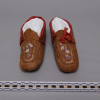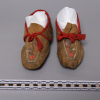Relatives/Heritage items
Displaying 2681 - 2700 of 4694 Relatives
Browsing allows you to see all the records for relatives and heritage items in the GKS. You can also search by material made, and/or filter by nations. To search by material made, type the material's name, by example 'leather', in the box below and click “Apply.” You can select multiple nations from the dropdown list by pressing “Ctrl” (on PC) or “Command” (on Mac) and clicking, then select “Apply.”
Round shell gorget on a cord, worn on the chest. Decorated with two copper and glass buttons. Possibly Haudenosaunee.
Blue and white strings or necklaces of wampum, noted as "marriage wampum strings" in accession file. Possibly Haudenosaunee, Abenaki, Huron-Wendat, or Penobscot.
Decorative panel of quilled hide, with braided fringe and tassels of hair and tin cones.
Purple and white wampum beads on vegetal fibre cord, with three carved bone effigies of birds. Possibly Huron-Wendat.
Burden strap with moosehair false embroidery. Huron-Wendat.
A pair of mid 19th century Huron-Wendat moccasins made with blackened hide and decorated with moosehair embroidery featuring floral motifs and zig-zag lines on the separate cuff and narrow puckered toe vamp. Purchased by Museum Volkenkunde from M.L.J. Lemaire in the 1960s.
A pair of snowshoes with flat rounded toe and tufts of red or brown yarn along the sides. Attributed to the Huron-Wendat from the mid 19th century. Acquired by Museum Volkenkunde through an exchange with the Christy Collection in 1869.
A pair of late 19th century Huron-Wendat moccasins with moosehair embroidery featuring floral motifs and zig-zag lines on the separate cuff and puckered toe vamp. Likely made for the tourist market, these moccasins were collected by Herman ten Kate and purchased from him by the
A pair of late 19th century Huron-Wendat moccasins with moosehair embroidery featuring floral motifs and zig-zag lines on the separate cuff and puckered toe vamp. Likely made for the tourist market, these moccasins were collected by Herman ten Kate and purchased from him by the
Late nineteenth century full-sized Hodenosaunee cradleboard with doll and beaded cover ornamented with floral patterns and a butterfly. Curved bow decorated in chipwork designs featuring possibly sun and moon motifs, with figurine hanging suspended in the centre. Collected by Herman ten Kate on the Tuscarora
A pair of Hodenosaunee moccasins from the late 19th or early 20th century decorated with raised floral beadwork on the vamps. Gifted to Museum Volkenkunde by H. Postma in 1992.
A pair of Hodenosaunee moccasins from about 1830, attributed to the Seneca. Made of possibly tanned deer hide ornamented with quillwork in zig-zag band and single line stitch. Transferred to Museum Volkenkunde from the Koninklijk Kabinet van Zeldzaamheden (The Royal Cabinet of Curiosities) in The
Miniature canoe made of birchbark and ornamented with moosehair embroidery in floral designs and domestic scenes possibly depicting gathering and cooking. Likely Huron-Wendat and made between 1830-1850. Purchased by the museum from A. Hakbijl in 1868.
Late 19th century oval shaped birchbark box ornamented with natural and dyed moosehair embroidery depicting two women paddling in a canoe on the lid surrounded by foliage and a floral wreath. Attributed to Wendat (Huron) or Wendat-Mohawk. Collected by Herman Ten Kate at St. Regis
A pair of Anishinaabe hair ornaments possibly made of ermine fur(?) and beaded medallions featuring an emanating six pointed starburst motif. Medallions are backed with metal clasps sewn to tanned hide for securing to hair. Created by Wendy Kaufman, from The Lac Courte Oreilles Band
Late 19th century Anishinaabe round lidded container made of quilled birchbark and bundle coiled sweetgrass. The lid is ornamented with an equal-armed cross motif against a natural birchbark background, and is tied to the body of the container with thread. Collected by Herman ten Kate
A 19th century Anishinaabe bowl made of a single piece of birchbark that has been cut and sewn with possibly spruce root(?). Wrapping of possibly dyed spruce root(?) secures and ornaments the wooden rim. Acquired by the museum through an exchange with the Christy Collection
Late 19th century Anishinaabe round lidded container made of quilled birchbark and bundle coiled sweetgrass. The lid is ornamented with an eight pointed star, or petalled flower motif against a natural birchbark background, and a series X's or crosses ornament the birchbark strip around the
A late 20th century Hodenosaunee cornhusk doll of a mother and child. The mother figure wears a dress of cornhusk and shawl of floral fabric, and in her arms she holds a baby tightly wrapped with different patterned fabrics. Oneida from Wisconsin, this doll was
Mid to late 18th or early 19th century Algonquin deer hide bag decorated with porcupine quills in a combination of hourglass and diamond, or lozenge, motifs that could be possible representations of thunderbirds and underwater panthers. Dyed deer hair(?) and metal tin cones attached with
 Knowledge Sharing Platform
Knowledge Sharing Platform




















